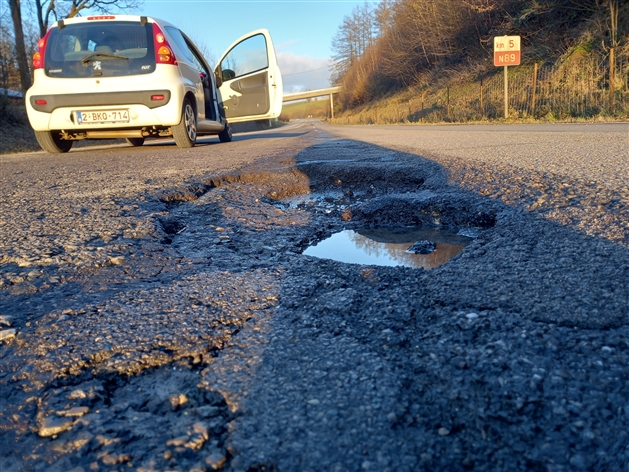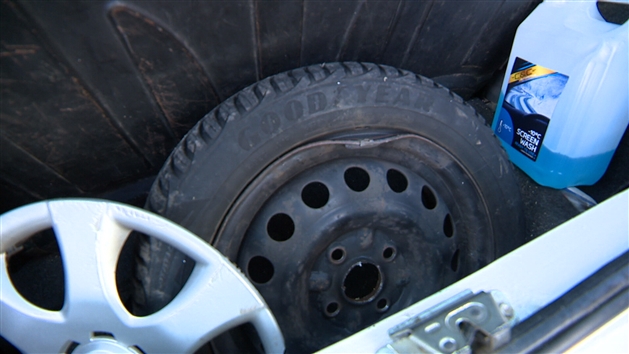The inhabitants of Bouillon and the surrounding area are exhausted: the roads of the Region are in a pitiful state. They are full of potholes. It is therefore difficult to avoid them. But, in the event of damage to a vehicle, who must compensate the motorist? Does insurance come into play? And the Region? Explanations.
“I took a nest of por on road n 89 towards Bouillon. The car is brokene and the Region does not want to pay. Is it normal ?”, Samuel asks us via the orange Alert us button. Samuel lives in Bouillon, a small village in the province of Luxembourg. And every year, he makes the same observation: the proliferation of potholes on the roads near his home. “We have a lot of truck traffic, day and night, which creates potholes quite often. Every year it is refilled but it comes back all the time”, he is indignant.
Potholes near Samuel’s
Last Friday, while he was going to the commercial area of Bouillon, Samuel took the n 89. This is where the incident occurred: “I left my house to go shopping, I had to overtake a heavyweight, and while overtaking, I hit a pothole”, he explains to us. Result : “Rim bent, steering ball joint and steering triangle damaged, and to be changed”.
In total, Samuel will have about 1,500 euros in damage. And this is not the first time that he has been faced with such a situation near his home: “It has to stop, it’s not the first time I’ve had damage. We are very disappointed with the state of the roads in the Region, we complain a lot. They are abandoned!”
But who should pay for the damage caused by the pothole? Is it the motorist? On insurance? Or to the road manager?
The compensation depends on the insurance held by the motorist
To see more clearly, we contacted the spokesperson for Assuralia, the Belgian insurance federation. Nevert Degirmenci explains to us that the compensation depends on the insurance held by the motorist. “The only insurance that intervenes for material damage suffered by a vehicle is the omnium insurance., she says. In the absence of omnium insurance, “it will be up to the driver alone to bear the cost of repairing his vehicle”, without insurance intervention.
Samuel does not have omnium insurance, but he does have so-called “legal protection” insurance. What can he expect?
According to the Assuralia spokesperson, there is another possibility: Samuel can submit a file to the road manager to hope to obtain compensation. A long procedure that can take from 6 months to 1 year. But thanks to the legal protection insurance, Samuel can count on the assistance of a lawyer or a lawyer to carry out his procedures, and perhaps obtain compensation more quickly, explains Nevert Degirmenci.
“To find the road manager, you have to check where the incident occurred. You have to turn to the public authority: is it the municipality, the province or the Region? identify this manager to introduce his file and hope to obtain compensation related to the repair of the vehicle”, specifies the spokesperson for Assuralia.
Two tools have been put in place so that users can quickly find out who manages which road. Sarah Pierre, spokesperson for the Walloon Public Service (SPW), details them:
- the toll-free number 1718, which is a toll-free number, informs a motorist at any time about the manager of a road
- or the WalOnMap application which lists all the roads that are part of the regional road network, and therefore managed by the SPW (see also this website).
If the insurance does not cover the accident, the Region may be held liable: Can Samuel hope to receive compensation?
In the case of Samuel, who manages the n 89? Against whom should he file a case? The Region, the province or the municipality? How can he prove the fault of the road manager?
“The first question to ask is, ‘Whose fault?’ this case since it is a regional road, it is to prove the fault of the Region which has the obligation to maintain its roads”, explains Renaud Vanbergen, a lawyer specializing in insurance and road traffic law for more than 10 years.

According to the specialized lawyer, there would be another way to prove that the Walloon Region is at fault: “This time it is not a question of fault but it is what is called the responsibility of the guardian: as soon as you are the guardian of something, and this is the case for the Regions for the regional roads, there has the obligation to compensate all those who have had damage since this thing (editor’s note, the road, in this case n 89), has a defect, i.e. an abnormal characteristic (note, here the pothole) which may cause harm to others”.
“It can be the case of an element that has fallen on the road but it is especially the case of a pothole which is a completely abnormal element. A normal road does not have a hole! And if that causes damage to someone who would have rolled in it, the Region must be able to engage its responsibility and compensate, it is established very clearly by the jurisprudence in Belgium”, he insists.
If all these elements are reported and proven, Samuel “can obtain compensation from the Region”. But how should he go about it? The most complicated thing is the proof, explains Renaud Vanbergen. “To win your case, you don’t just have to be in the right, you have to be able to prove it and that’s not always easy.” he warns.
What should be considered at the time of the accident to successfully prove the responsibility of the Region or the road manager?
How should Samuel go about proving the responsibility of the Walloon Region? What are the first things to do when you have an accident involving a road fault? Renaud Vanbergen enlightens us: “If there is an accident, you have to call the police to see the damage. But also remember to note the kilometer post to know where exactly the accident took place so that you can return to the scene and see whether or not there is indeed a pothole there. In general, a declaration must be made to the insurer as soon as possible because this declaration can have a probative effect if it is made as quickly as possible. he details.
But you also need “gather as many photos and testimonials as possible, and attach an estimate or the repair invoice”, adds the Assuralia spokesperson.
This is confirmed by Sarah Pierre, spokesperson for the SPW. According to her, “en the case of damage linked to a road problem, people must follow a procedure which can lead to compensation, but this is not systematic”she explains. On its website, the SPW details all the procedure to be continued. Sarah Pierre adds that the “Dossier must include several criteria to be admissible”. To know :
- A full description of the incident including date and time
- The cause of the incident, and its precise course
- Photos of the damage
- Photos of the place where the incident occurred (if possible, always guarantee the safety of the user)
- The estimate or the invoice for repairing the damage
- The police report if the police came to see the damage
- And the testimonies of people who witnessed the incident if there are any
The request must be sent by email or by post to the territorial department concerned, which will make an initial analysis of the file, explains Sarah Pierre. “An expertise is then carried out by an approved company which will be responsible for confirming the link between the state of the roads, the damage and the amount of compensation”, she adds. The file is then sent to the SPW litigation department, which will either accept or reject the request.
“You should know that each rejection is motivated. The user is warned that, for example, a key element is missing in the file. He is also invited to send a more complete request”, explains the spokesperson.
In the case of Samuel, it is the insurer who is responsible for setting up the file to request compensation from the Walloon Region. Luckily, Samuel thought about everything the day of his accident: “I immediately called the police who came to see the damage and the pothole”. He then took care to photograph the kilometer post and the pothole, as well as the damage caused to his vehicle.

Pothole and kilometer marker photographed by Samuel on the day of the accident © Samuel via Alert us.

Some of the pothole damage to Samuel’s vehicle
Despite all this evidence, Samuel’s insurer is not optimistic about possible compensation: “Ils told me it was going to be complicated. From its experience, the insurer told me that the Region was going to defend itself. He clearly told me that they had an obligation to maintain but that it would still be all at my expense. We still make the request but he told me that it was a bit ‘hit and miss'”, Samuel tells us.
Call a lawyer to have a better chance of being compensated
Renaud Vanbergen advises to call on a lawyer to combine all the chances on his side and hope to obtain compensation: “The best thing is to call on a lawyer since he is a legal and litigation professional. The lawyer will contact the Region, therefore his government or the competent ministry, and a discussion will take place with the administration to establish responsibility, the evidence. And if we conclude on liability, we will agree on the amount of compensation. There will also be an expertise on the car for the damage”he explains.
The specialist lawyer says he was confronted “frequently” with this type of file, given the state of the roads in the Walloon Region. According to him, a lot of court decisions are published on this subject: “There are indeed quite frequent cases where the responsibility of the Regions is established in this case”.
Could there be a glimmer of hope for Samuel? In all cases, he will have to advance the repairs, ie 1,500 euros, and provide the estimate in his file.
–


